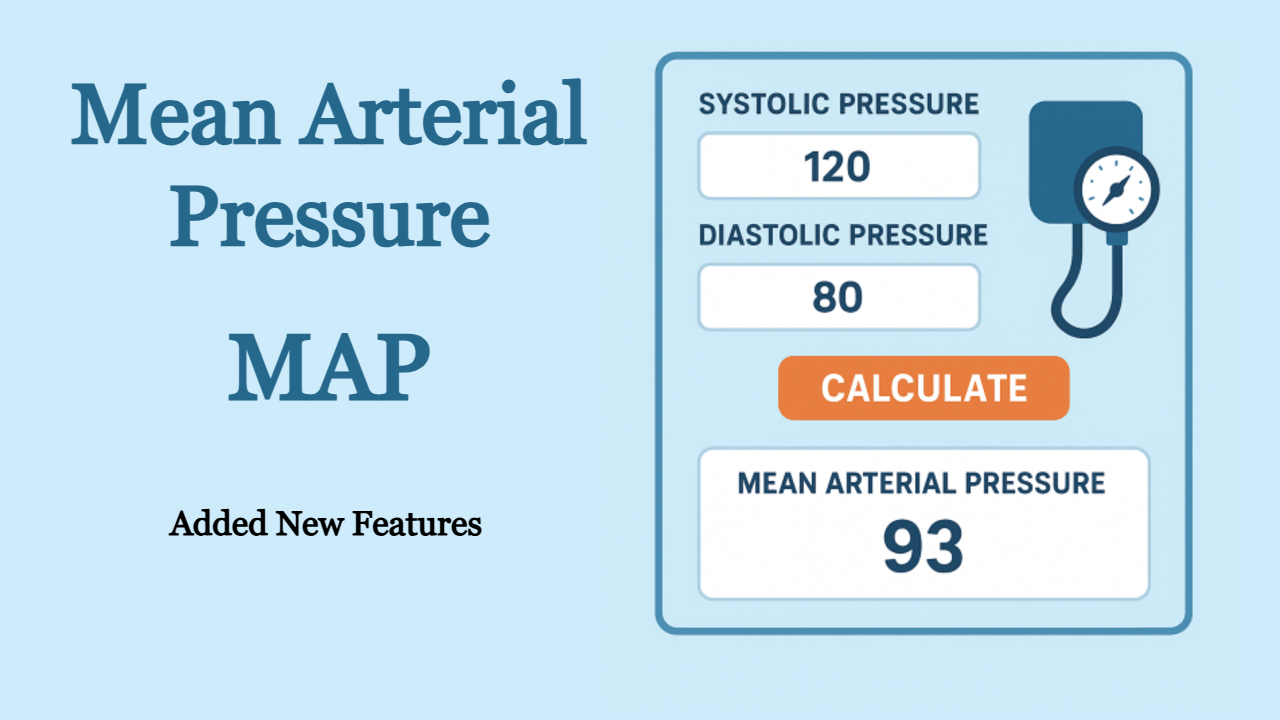MAP Calculator (Mean Arterial Pressure)
Based on AHA guidelines, your blood pressure category is determined when you calculate MAP.
Explore More Calculators

Love Calculator
Check love compatibility in seconds

Time Calculator
Easy time calculator for hours and minutes

Age Calculator
Instantly calculates age from date of birth

Percentage Calculator
Calculates percentages instantly
The MAP Calculator (Mean Arterial Pressure) is a vital tool in healthcare, helping doctors and patients understand how well blood flows through the body’s organs. Unlike only checking systolic blood pressure (SBP) or diastolic blood pressure (DBP), the MAP Calculator shows the average pressure in your arteries during a full cardiac cycle. This measurement is crucial because it reflects the body’s ability to maintain proper tissue perfusion, ensuring that oxygen and nutrients reach vital organs. A normal MAP range is often considered more reliable than just looking at blood pressure readings. With the MAP Calculator, you can better track, evaluate, and protect your heart health effectively.
What is Mean Arterial Pressure MAP Calculator?
Mean arterial pressure (MAP) is the average pressure in your arteries during one full cardiac cycle. Unlike systolic blood pressure (SBP) which is the pressure when the heart contracts, or diastolic blood pressure (DBP) which is the pressure when the heart rests, MAP reflects the overall force that pushes blood through the vessels.
Doctors use MAP because it shows how well your organs are getting oxygen and nutrients. Proper tissue perfusion depends on having a stable MAP. If the MAP drops too low, the brain, kidneys, and heart may not receive enough blood, which can be dangerous. If it goes too high, the blood vessels and organs can get damaged over time.
Why is MAP Important for Your Health?
MAP is a vital number because it tells whether your blood is reaching all vital organs in the right amount. Without enough pressure, tissues suffer, leading to organ damage. This is why patients in sepsis / septic shock, trauma, or head injury and blood pressure control are closely monitored for MAP in hospitals.
A normal MAP ensures that your body maintains balance. For example, a MAP below 65 mmHg can be life-threatening because it means organs are not receiving enough blood. A MAP above 100 mmHg may increase the risk of hypertension (high blood pressure) complications like stroke, heart attack, or kidney disease.
How is Blood Pressure Measured?
The most common way to measure blood pressure is with a blood pressure monitoring device / digital BP machine or a manual sphygmomanometer and stethoscope. This method measures SBP and DBP, from which MAP can be calculated.
Doctors sometimes face white coat syndrome / white coat hypertension, where patients show higher readings only in medical settings. This is why home monitoring with a digital machine is often recommended. Regular checks reduce errors and provide a more accurate MAP calculation.
MAP Formula - How to Calculate Mean Arterial Pressure
The MAP formula / MAP equation is simple. You add the diastolic blood pressure (DBP) to one-third of the difference between systolic blood pressure (SBP) and DBP.
MAP Equation:
MAP = DBP + 1/3 (SBP – DBP)
This is called manual MAP calculation, but you can also use an online MAP calculator for accuracy. Learning how to calculate MAP from BP helps patients and doctors quickly check circulation health.
Pulse Pressure (PP) and Its Relation to MAP
Pulse pressure (PP) is the difference between systolic and diastolic pressure. The formula for pulse pressure calculation is simple:
PP = SBP – DBP
This number is important because it shows how much blood is pushed out of the heart with each beat, also called stroke volume. A high or low PP affects hemodynamics and can change MAP. For example, stiff arteries or anemia can increase PP, while shock can lower it.
Normal Ranges of Blood Pressure and MAP
Doctors use set values to define a normal blood pressure range and normal MAP values.
Condition | SBP (mmHg) | DBP (mmHg) | MAP (mmHg) |
Normal | <120 | <80 | 70–100 |
Prehypertension | 120–139 | 80–89 | 101–105 |
Hypertension | ≥140 | ≥90 | >105 |
Hypotension | <90 | <60 | <70 |
These values are important to understand because they help explain what happens if MAP is too low or what happens if MAP is too high.
Hemodynamic Determinants of MAP
Hemodynamics is the study of blood flow in the body. MAP depends mainly on cardiac output and the resistance of blood vessels. Cardiac output is measured using a cardiac output calculator, and it is the product of heart rate and stroke volume.
When the heart pumps faster (tachycardia) or slower (bradycardia), or when vessels widen due to a vasodilator infusion (e.g., nitroglycerine), MAP changes. Similarly, drugs like norepinephrine raise MAP in patients with very low pressure.
Advantages and Limitations of MAP Measurement
MAP is more reliable than using SBP alone. It gives a better view of tissue perfusion and overall circulation. In critical care, doctors depend on MAP more than simple BP readings to guide treatment.
Still, MAP has limits. In cases of irregular heart rhythms, or patients with very high intracranial pressure (ICP), the reading may not tell the full story. Also, in special cases like mean pulmonary artery pressure (mPAP), separate measurements are needed.
When Should You Monitor Your MAP?
You should monitor MAP when there are risks of organ damage. Patients in sepsis, trauma, or head injury and blood pressure control are monitored continuously. MAP is also important in major surgeries to ensure stable circulation.
Even outside hospitals, patients with hypertension, prehypertension, or hypotension should know their MAP. Regular use of a digital BP machine or MAP calculator helps spot issues early.
Hypertension and Low MAP - Health Risks and Complications
Hypertension (high blood pressure) raises MAP and increases the risks of high blood pressure such as stroke, heart failure, and kidney disease. Patients may also experience symptoms of high blood pressure like headaches, dizziness, or nosebleeds.
On the other hand, hypotension (low blood pressure) lowers MAP and increases the risks of low blood pressure such as fainting, shock, or organ failure. Symptoms of low blood pressure include fatigue, blurred vision, and confusion.
Comparing Different Blood Pressure Scenarios Using a MAP Calculator
Two people can have different SBP and DBP values but a similar MAP. For example:
Patient | SBP | DBP | MAP |
A | 120 | 80 | 93 |
B | 100 | 60 | 73 |
Although patient A looks normal and patient B looks low, both values fall within acceptable ranges for organ perfusion. This shows how a MAP calculator can reveal hidden risks not clear from SBP and DBP alone.
How to Improve and Maintain a Healthy MAP (Heart Health Tips)
Maintaining a good MAP requires lifestyle changes for healthy MAP. Doctors recommend exercise and blood pressure control, a diet for hypertension control, and quitting smoking. Foods low in sodium and rich in potassium improve heart health.
People at risk should also learn how to improve heart health naturally and how to lower blood pressure safely. Doctors sometimes use medicines like vasodilator infusion (nitroglycerine) or norepinephrine in emergencies, but in daily life, lifestyle is the most powerful tool. Regular checks with a target heart rate calculator, QTc calculator, or MAP calculator help track overall heart function.
Conclusion
A MAP calculator is more than just a medical formula. It is a tool that gives real insight into how well the heart is supporting life. By understanding mean arterial pressure (MAP), you can better protect your organs, prevent complications, and live a healthier life. Always remember that normal MAP values are the foundation of proper tissue perfusion.
Monitoring your MAP regularly, making smart lifestyle choices, and seeking medical help when needed are the keys to long-term heart health.
FAQs
How do you calculate the MAP?
MAP is calculated using the MAP formula: (SBP + 2 × DBP) ÷ 3.
What is a normal mean arterial pressure of 69?
A MAP of 69 mmHg is slightly below the normal MAP values (70–100 mmHg) and may reduce organ perfusion.
How do you calculate MAP value?
You calculate MAP by using systolic blood pressure (SBP) and diastolic blood pressure (DBP) with the formula (SBP + 2 × DBP) ÷ 3.
How to calculate MAP brain?
For the brain, MAP is compared with intracranial pressure (ICP) to determine cerebral perfusion pressure (CPP = MAP – ICP).
What is a MAP and how do you calculate it?
MAP is the average pressure in arteries during one cardiac cycle, calculated with (SBP + 2 × DBP) ÷ 3.

